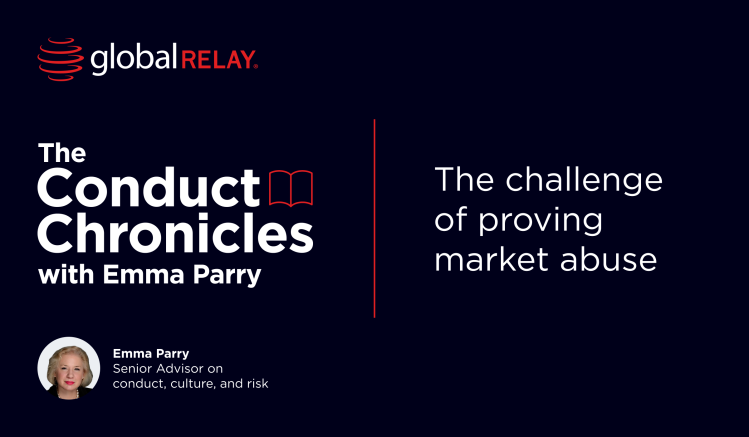
The Conduct Chronicles – The challenge of proving market abuse
With the proliferation of communications channels and the evolution of tech, data completeness has never been more critical in tackling market abuse.
Written by a human
In a speech in 2022, the FCA spoke of the challenge in bringing successful market abuse cases to court, noting that:
‘Quite rightly the burden of proof in a criminal case is high – beyond reasonable doubt. However, in many of the reports or concerns we review, strong suspicion is often matched by weak or non-existent evidence.’
In the same speech, it provided insight into the work it does to assess and understand market cleanliness, stating that it conducts daily monitoring to ensure the timeliness and accuracy of the disclosure of inside information. At the time, the information it was analyzing was sizeable – amounting to over 30 million transaction reports and over 100 million order reports a day from firms and venues.
In addition to the significant data analytics effort undertaken by regulators including the FCA, specialists provide insights into the prevailing market conditions given that abnormal price and volume movements can be triggered by a host of legitimate reasons, including for example, geopolitical events. Not all abnormal price movements are the result of manipulation.
Finding cases of market abuse in amongst a vast sea of data is challenging. Even more challenging is proving market abuse and bringing a successful case to court.
ESMA has also highlighted the complexity in investigating potential market abuse:
‘Insider dealing and market manipulation infringements imply extensive investigations and complex evidence gathering exercises. Sanctioning those infringements is likely to require more work and longer delays than administrative measures imposed for other infringements e.g., breaching the obligation to report the transactions executed under an accepted market practice’
Unsurprisingly, it all comes down to data
A criminal case, or indeed a civil case that rests on a balance of probabilities, depend upon the ability to reconstruct a series of events. And whether criminal or civil, in both scenarios, court cases depend upon the completeness and accuracy of the data.
If we consider a market manipulation scheme such as ‘pump and dump,’ and what an investigative team needs to build a case, then the requirements for complete and accurate data alongside sophisticated analytical capabilities become very clear.
‘Pump and dump’ is a form of market manipulation where stock is artificially ‘pumped’ to lure in investors to buy, only for the perpetrators inflating the stocks to sell (‘dump’) when the stock is high, leaving those remaining with significant losses. Schemes can involve not only stock but also crypto and are increasingly being facilitated via social media platforms and messaging apps.
For a ‘pump and dump’ case to be successfully proven in a court of law, investigators will rely upon a diverse and disparate range of data which will include many of the following:
- Trading data that identifies groups of individuals who traded in the same stock, in the same direction at around the same time
- Trade account data that identifies the individuals having opened accounts at a similar time or having the same account contact details
- Payment account data specific to the individuals under investigation and showing payments into and out of the accounts during the period in question
- eComms data (eg. chatrooms, messaging apps) with evidence of the ‘pump and dump’ messaging to potential ‘investors’ alongside details of the asset being ‘pumped’ (eg. stock, crypto)
- Market data for the asset in question – ie. Before and after the market manipulation has taken place, and
- From a regulatory standpoint, firms may have raised Suspicious Transactions & Order Reports (STORs) specific to the stock highlighting concerns over sudden and unexplained price movements.
It’s not Mission Impossible
Despite the complexity of proving such cases, there have been some notable successes in the fight against pump and dump schemes. For example, in July 2024, Australian regulator ASIC announced that following its investigation, four people had been ‘criminally charged for their alleged involvement in a coordinated scheme to pump up shares in Australian stock values before dumping them at inflated prices.’
Setting out its allegations, ASIC stated that ‘in an organized operation the defendants formed a private group on the Telegram app where they discussed and selected penny stocks to announce to the public Telegram group named the ‘ASX Pump and Dump Group.’’
Of course, given the way in which the investigation evolved, the case also outlined that, in October 2021, ASIC had directly joined the Telegram ‘ASX Pump and Dump Group’ chat room and warned its members that coordinated attempts to manipulate the market was a criminal offenze.
If found guilty, the defendants face a maximum penalty of 15 years’ imprisonment and a fine of over A$1million for market manipulation.
Adapting to Change
Capital markets trading continues to evolve. High frequency trading, alongside the increasing use of algorithms and direct market access (DMA) solutions have significantly increased the volume of data that must reviewed and analyzed to detect potential market abuse.
Added to this, social media has turbo-charged the speed at which information is widely disseminated, and therefore increased the speed at which market manipulation can occur. It has also enabled cross-border fraud, making the pursuit and prosecution of perpetrators more challenging, although not impossible, given the cross-border cooperation of regulators and enforcement agencies.
Unsurprisingly, given the rising threat, regulators around the world are increasingly monitoring social media platforms, chat rooms and blogs to detect market rumors and false or misleading information that may influence the market. And, in the case of ASIC, they are running direct disruption campaigns on messaging platforms such as Telegram to tackle market manipulation at the source.
As technology evolves, so to must the industry evolve in the way in which it thinks about and tackles market abuse. However, the fundamentals will never change. Firms must continue to identify and close the risk gaps. And, at the core, the basic controls must be in place. Firms, and indeed regulators, must ensure data completeness and accuracy, whilst ensuring that effective record keeping policies, procedures and solutions are implemented.
We mustn’t forget that what the ‘WhatsApp’ record keeping fines have highlighted is that, as an industry, we are missing essential eComms data. And crucially, that eComms data may – or may not – have included evidence of market abuse. We will never know.



